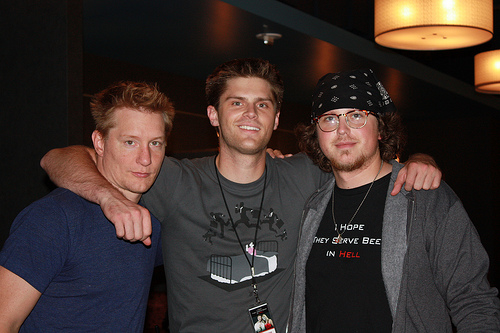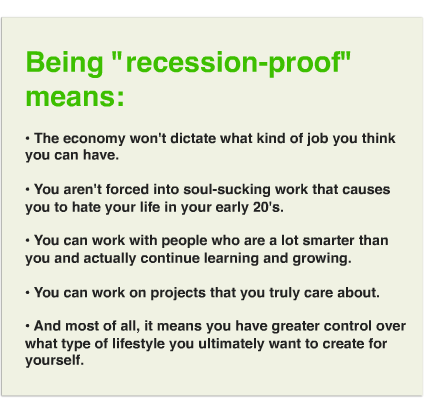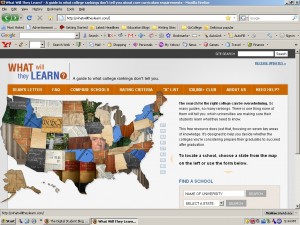College Admissions
College Admissions
Preparing for College
The Best College for You
What to Study
Applications
Education Options
Education Options
Private Universities
Public & State Universities
Community Colleges
Scholarships
Scholarships
African American Scholarships
Latino Scholarships
Native American Scholarships
Women Scholarships
College Grants
College Grants
Federal Grants
Merit Based Grants
Need Based Grants
Student Loans
Student Loans
Federal Student Loans
State Student Loans
No Co-signer Student Loans
Bad Credit Loans
Student Loan Consolidation
College Survival
College Survival
Financial Aid Tips
The Digital Student Blog
Five reasons why the aid act may be bad for students.
There has been a pause in Washington as all eyes focus in on the healthcare debate. But very soon the Senate will be taking up an important measure related to college students and financial aid that was previously approved by the House.
TheMiddleClass.org offers the following summary of that bill, The Student Aid and Fiscal Responsibility Act of 2009:
The Student Aid and Fiscal Responsibility Act terminates the Federal Family Education Loan program, which provides subsidies and guarantees to private lenders that make student loans. Instead, the federal government would issue student loans directly to borrowers. Ending the subsidization program would save the government $87 billion over ten years. The Act ensures that interest rates on student loans remain affordable. Additionally, the legislation increases the maximum Pell Grant, a need-based grant designed for lower-income students, from $5,350 in 2009 to $5,550 in 2010 and $6,900 in 2019.
The Student Aid and Fiscal Responsibility Act includes funds for programs to encourage completion of college and subsequent employment, particularly for students from underrepresented backgrounds; for Historically Black Colleges and other minority-serving institutions; for early-childhood education; and for school modernization and repair. The bill also provides funds for improving the community college system. The legislation simplifies the Free Application for Federal Student Aid (FAFSA), which determines eligibility for student aid.
Such a summary has most folks taking the stance that the recent approval of the legislation by Congress is a massive step forward for students and families. As but one example, the Seattle Times offered extremely high praise, noting that “Congress’ overhaul of the college student-loan system offers welcome relief to students at risk of drowning in debt.”
College students backing SAFRA recently put together a YouTube video:
Certainly the legislation borders on the historic. Terry Hartle, senior vice president at the American Council on Education, indicated that the legislation “is the biggest change in federal loans for higher education since 1965, when the original program was created.”
But those following the issue realize that support for the legislation is falling along party lines: Democrats in support, Republicans in opposition. Therefore, one can quickly surmise that the new program conflicts with certain conservative principles.
Perhaps even more importantly, as the legislation becomes clearer many others, irrespective of party affiliation, have begun questioning this massive change. Indeed, after listening to those critics, we too have begun to wonder aloud.
Is the legislation really a positive step for students and their families?
Issue One – Categorizing the Middle Man as a Corporate Monster
One highly touted aspect of the legislation is the move to make the federal government the direct lender to students. In taking this step, the goal is to remove the so-called ‘middlemen’ from the loan process.
Banks are certainly pushing back, after all college loans have served two purposes. The interest on the initial loan is but one positive element for banks. A second and perhaps larger segment has to be the opportunity to create new customers.
But while most equate banks and profits with the middlemen term, the fact is there are many local agencies handling the loan process for students. Most are nonprofits, working to ensure that the loan process, from borrowing through repayment, goes smoothly.
The legislation as currently enacted eliminates all agencies handling these funds including some highly-valued nonprofits. For example, one such nonprofit, the New Hampshire Higher Education Assistance Foundation (NHHEA), works with nearly 30,000 New Hampshire students and parents each year, offering free college planning and information related to financial literacy and financial aid.
But under the proposal, intuitions such as NHHEAF would also be eliminated.
Issue Two – A Potential Increase in Loan Defaults
As noted previously, these local nonprofit centers focus on educating students in all financial matters. They not only offer financial literacy programs for student borrowers and financial aid preparation for students and their families, they also offer programs that promote early college awareness.
Such training goes a long way in terms of developing greater student understanding of the loan process. As but one example again, NHHEAF can claim one of the lowest default rates in the nation.
Needless to say, this loss of local services could well mean far more in the way of potential student loan defaults.
Issue Three – No Savings for Students or Families
Clearly there is major support for “eliminating subsidies to lenders,” particularly after what has transpired over the last year in the financial world and the role banks have played in it. But upon hearing of the elimination of these subsidies, the public immediately assumes the result will be a reduction in program expenses.
It appears instead of passing along savings to students, the current proposal may well cost students more. According to the Chronicle of Higher Education, the “federal government isn’t providing any breaks to the students” and ultimately will be making more off the program than lenders ever could.”
It may well be that the money raised will be doled out in the form of increased Pell Grants, but those grants will essentially be funded from students paying off other loans, not necessarily from increased support from the federal government.
In addition, those schools currently utilizing other loan programs will need to invest staff, time and money to change systems and processes. This would need to take place at the same time that schools have axed budgets to the bare bones.
The costs associated with implementing the program will likely be passed on to students through increased tuition and student fees.
Issue Four – Handling the Increased Demand
The legislation by Congress assumes that the government can effectively and efficiently step up and run the new program. According to Martha Holler, a spokesperson for Sallie Mae, in order to implement the proposal, “about 4,500 schools would have to convert lending systems. It’s not like putting a different disk in their PC; the whole system has to be reworked.”
 The result, “The U.S. Department of Education will be tasked with converting an average of nearly 500 schools a month over the course of a nine month period,” notes Tara Payne, Vice-President of Corporate Communications for NHHEAF. “Since the Direct Loan program’s inception in 1993, roughly 1,600 schools have been converted over a 16 year time-frame.”
The result, “The U.S. Department of Education will be tasked with converting an average of nearly 500 schools a month over the course of a nine month period,” notes Tara Payne, Vice-President of Corporate Communications for NHHEAF. “Since the Direct Loan program’s inception in 1993, roughly 1,600 schools have been converted over a 16 year time-frame.”
Issue Five – Increasing the National Debt
According to the Office of Management and Budget (OMB), under budget proposals that include the switch to 100-percent Direct Lending, the debt held in the Government’s various Direct Loan accounts is expected to rise from $632 billion in FY 2009 to $1.58 Trillion in FY 2019, an increase of more than $900 billion. Therefore, nationalizing the direct loan program will add substantially to the national debt over the next decade.
This means that those who benefit from the loans will actually pay twice, once when paying off the original loan and a second time when he or she pays the taxes necessary to eliminate the ever increasing national debt.
Of course some insist that the basis of the proposal is to deal with the larger budget issues, that any savings created by program changes will be used to plug budget gaps instead of providing additional funds for higher education.
Questioning the Change
These five issues have us and others questioning the government take-over of a public-private program that has seemingly supported students and schools, especially those who have borrowed judiciously in the past.
How College Sports Continues to Sell its Soul.
I cannot remember the first time I heard someone suggest Division I athletics bordered on a form of prostitution. Though previously I had deemed such a suggestion excessive hyperbole, this past weekend we became witness to why that ugly word is used to describe college athletics.
On Saturday, Delaware State, a small 1-AA FCS football program, had the unenviable task of traveling up to Ann Arbor to take on the 1-A FBS Michigan Wolverines. As expected, the game, which should never have been played, was a rout of monumental proportions.
 The Wolverines (5-2) set several team records including 442 total yards of offense in the first half and 727 for the game in a 63-6 rout. Michigan matched a school record by scoring 28-points in the first quarter and their 49 points by halftime were the second-highest in school history.
The Wolverines (5-2) set several team records including 442 total yards of offense in the first half and 727 for the game in a 63-6 rout. Michigan matched a school record by scoring 28-points in the first quarter and their 49 points by halftime were the second-highest in school history.
But truth be told, such routs happen quite often in the world of college athletics, particularly in football when teams with disparate resources get together to ‘compete’ on the field. Therefore, in most instances, the Michigan-Delaware State game would simply be relegated to the NCAA hinterlands if not for a back story that demonstrates the sometimes vile world of college athletics.
Two Losses the Same Day
Sports sites noted that Delaware State actually lost two football games on Saturday. In addition to the pasting they received at the hands of Michigan, the team forfeited a game against fellow Mid-Eastern Athletic Conference foe North Carolina AT&T, a game that had been scheduled prior to the agreement to play Michigan.
In fairness, the initial mistake of two games being scheduled on the same date came while Delaware State was searching for an athletic director. But the choice of what game to play, and subsequently which to forfeit, demonstrates why so many are down on the world of college athletics.
Seems that Delaware State was offered $550,000 to go to Ann Arbor and play the role of football fodder for the Wolverines. And administration at the school decided that sum of money was just too much to pass up.
The Decision
According to reports, given the opportunity, Delaware State signed a contract to play the game in Ann Arbor despite having already committed to playing AT&T on the same date. The contract did allow Delaware State to cancel for a fee, the amount of which was not made public.
 Of course, once everyone realized a mistake had been made, Michigan could have done a classy thing and released Delaware State from the contract. But then again, if Michigan could afford to pay Delaware State $550,000 just to appear, one can gather that the lost revenue from a home game would represent a sum of money that made the half-million payout seem inconsequential..
Of course, once everyone realized a mistake had been made, Michigan could have done a classy thing and released Delaware State from the contract. But then again, if Michigan could afford to pay Delaware State $550,000 just to appear, one can gather that the lost revenue from a home game would represent a sum of money that made the half-million payout seem inconsequential..
At the same time, Delaware State officials could have done the right thing and honored their league commitment against AT&T. Of course, given Michigan’s stance, to do so meant State would have had to pay the required fee for backing out.
Instead of either school honoring the spirit of amateur athletics, i.e. handle a loss with dignity and class, both opted for the opposite. Both put large sums of money in front of integrity and, as a result provided a sorry message to the athletes on their respective teams.
Many Fumbled the Ball
Beyond the physical mismatch that constituted the so-called ‘game’, the decision by Delaware State to take the money also meant it put the integrity of its league at risk. The choice to forfeit could well impact the final league standings and ultimately, the status of numerous other conference teams in the process.
Given that both levels of football have a supervisory agency, the NCAA, one would think that leadership beyond the two schools would have taken issue with the decision to allow money to alter the integrity of the sport. Apparently, not so.
Today we understand why some would use the word prostitution to describe college athletics. Yes, such a statement borders on the outrageous.
But what these two universities did in the name of college football could only be described in such terms.
We have frequently highlighted the roll of social media in college, even when it turned out to be a bad fit. Some professors have taken a liking to it, particularly note passing on Twitter. Going one step further, College Scholarships is incorporating Twitter into a scholarship now. Students may enter the 140 Scholarship by Tweeting their answer to the following question “how we Twitter be used to improve the world?”
It is deemed to be one of the “most popular courses in Harvard’s history.” And now, thanks to WGBH television and Harvard University, every American has an opportunity to examine the moral and ethical issues that form Michael Sandel’s course “Justice.”
In opening this classroom to the world, Harvard gives us a taste of the future of higher education. With the proper preparation and a gifted-instructor, the course is proof-positive that high quality education can be delivered online.
In fact, one might honestly ask, what is the advantage of actually being seated in the auditorium where Sandel teaches. The incredible numbers of students eliminate any intimacy and any real possibility of discussion within the “classroom setting,” i.e. stadium-style lecture halls.
That said, the critical components of the twelve-part series are the content and the complex moral questions being posed. Addressing the hot topics of our day (affirmative action, same-sex marriage, patriotism and rights), Sandel offers a constant stream of provocative questions that provide for outstanding discussion opportunities.
As but one example of how to use content to drive instruction, in episode 2, How to Measure Pleasure, Sandel offers video clips from three distinct and different elements of the entertainment world: clips from Shakespeare’s Hamlet, the reality show Fear Factor, and The Simpsons.
The course also features opinion polls, pop quizzes, in-depth readings and discussion guides offering two levels of debate, beginner and advanced depending on your current background.
As for one rationale for the online version exceeding the traditional classroom model, online classes now offer literally endless possibilities for rich discussions with viewers from around the world. Not only are such discussions impossible in the auditorium where the class is presented, online discussion forums remove the need for students to gather collectively on a single campus.
The two drawbacks? First, there is that same mentality that features the typical time constraints of all education, materials are being released weekly.
Second, the method for earning those all-important credits that can be collected to earn a college diploma.
But as for the model of what could be, Justice is the real deal!
By all accounts, the job placement data for the Class of 2009 was exceedingly dismal. While everyone is hopeful of a better future and most signs point to an economy on the rebound, career experts insist that the Class of 2010 could well see similar job placement challenges.
The reason is quite simple – it seems that the poor 2009 job placement rates came in great part because a large number of 2008 graduates had been unable to secure a job in their field. Now, the Class of 2010 faces a double whammy, the cascading effect of two consecutive poor placement years.
Therefore, even as the economy turns the corner, next year’s grads will be competing with a number of currently unemployed folks for the few additional jobs that become available.
Becoming a Recession Proof Graduate
Given this sobering scenario, today we turn to Charlie Hoehn, the author of the interesting SlideShare ebook, “Recession Proof Graduate.” A 2008 graduate of Colorado State University, Charlie holds degrees in marketing and media studies.
 Currently touring the country with Tucker Max during the screening of his new movie: I Hope They Serve Beer in Hell, Charlie continues to work with Ramit Sethi, a partnership that led to Sethi’s recent book becoming a NY Times and Wall Street Journal best-seller, and with Tim Ferriss, author of the NY Times best-seller, The Four-Hour Workweek.
Currently touring the country with Tucker Max during the screening of his new movie: I Hope They Serve Beer in Hell, Charlie continues to work with Ramit Sethi, a partnership that led to Sethi’s recent book becoming a NY Times and Wall Street Journal best-seller, and with Tim Ferriss, author of the NY Times best-seller, The Four-Hour Workweek.
Charlie provides some pretty radical advice in Recession Proof Graduate. After reading his recommendations, we wanted to give Charlie some time to discuss his job search process, particularly his decision to throw out the traditional search model after seeing conventional techniques produce dismal results for him.
In your book, you talk about your initial job search upon graduating and the difficulties you had. At some point you came to the realization that the recession was not the issue, it was your use of conventional job-hunting methods and your expectations related to that search. Which realization came first, the need to change your expectations or your need to try a new search technique?
The need to change my expectations definitely came first. After I got turned away from a company I’d interned with for three months (and they LOVED me, by the way), I kinda knew the odds of me finding a well-paying, fun job were pretty slim. I changed my job hunting tactics later on out of sheer desperation, after trying the traditional methods for a few months and seeing godawful results.
You certainly turn one standard goal of the job search process on its head. Can you explain why the goal for graduates should not be focused so much on making loads of money?
I’m all for making a lot of money, but I knew that I didn’t necessarily deserve a big paycheck right away. I had to earn that right. So I think the goal for graduates should not be to immediately find a high paying gig, but rather to figure out how to maximize their potential future earnings. This can be done by learning in-demand skills, doing free work for specific people, etc. This way, you’re setting yourself up for making more money in the long run, while also making yourself more valuable as an employee and building your network.
 Another reason I don’t think grads should be too focused on money is because it will REALLY force you to figure out what your priorities are. I have a few friends who jumped into industries they don’t like because they were tempted by the promise of $60-80K in the first year on the job. Even I played with the idea of being a landman for an oil and gas company because I would have made $70K straightaway. But I also would have quickly grown to hate my life. And after a certain point, I would have been so emotionally and financially dependent on that big paycheck that there’d be no turning back. It’s far better, I think, to do free work for a few months. You’ll figure out what you truly want to do.
Another reason I don’t think grads should be too focused on money is because it will REALLY force you to figure out what your priorities are. I have a few friends who jumped into industries they don’t like because they were tempted by the promise of $60-80K in the first year on the job. Even I played with the idea of being a landman for an oil and gas company because I would have made $70K straightaway. But I also would have quickly grown to hate my life. And after a certain point, I would have been so emotionally and financially dependent on that big paycheck that there’d be no turning back. It’s far better, I think, to do free work for a few months. You’ll figure out what you truly want to do.
And really, should a student consider throwing away their resume?
Maybe not literally, but I do think resumes suck. Just from an aesthetic standpoint, I think resumes are awful. They all look the same — plain and boring — and when you consider that you’re in a pile with dozens (and sometimes hundreds) of other resumes, you have to realize that it’s nearly impossible to stand out. The average graduate will not have any remarkable credentials under his belt, so how is he going to beat out all these other faceless resumes? He won’t. So I say throw away your resume. A one-page document shouldn’t represent your past, present, and future. A blog or a portfolio are superior alternatives, and they can vividly illustrate a person’s thought process and skills.
The idea of working for free to obtain critical experience and skills isn’t really new is it? Is this not just the concept of an internship? And, didn’t you get the skills you needed in college?
Free work is very different from an internship, as Seth Godin pointed out. Free work allows you to work on your own terms: you get to work with the people you want to, on the projects you want to work on, in the industry you want to work in. The relationships with the people you work for will develop organically, and they won’t look at you as just an intern — they’ll actually want to help you learn and grow.
Did I get the skills I needed while I was in college? Yes and no. Yes, because all of the skills I’m currently hired and paid for were things I taught myself while I was in college. No, because college didn’t really teach me any new skills that employers would want to hire me for. College gave me a degree, a GPA, and four years of fun memories. None of those hold much weight in a recession.
In your ebook you explain that many folks insist that you have this new job search process all wrong – one honest fear of some of the folks I have talked to is that once you work for free that will become the ongoing expectation – how do you respond to folks who raise this concern?
I briefly addressed this at the end of the e-book. It’s all about managing expectations. If you don’t lay down a deadline for when the free work transitions to paid work (or introductions to other people, new opportunities, etc.), then you’re setting yourself up to be taken advantage of. Most people who take you under their wing to do free work will be more than willing to reciprocate and help you out if you do a really great job, but you need to make that clear upfront. I’ve done free work for a bunch of people over the last year and a half. I only felt like I got burned once, and that was when I did work for a struggling entrepreneur who was working on his first startup (which is why I recommend that graduates work for successful entrepreneurs).
I also try to work with people who are dependent on maintaining a strong, healthy personal brand online. I’ve built up enough credibility and have enough followers that it’s a bigger liability for them if they take advantage of me. This is not to say I would ever hold this over their head, or threaten them with it if things started to go poorly. Rather, it’s just to point out that it’s in their best interest to take care of me (which they do).
One key element is the suggestion to seek to do this free work virtually – why is this a point of emphasis in the process?
Doing work virtually really frees you up to work with anyone you want — you’re not limited to whatever local opportunities are available. You can work with people in other states, or other countries. Virtual free work is probably the best dynamic for graduates, because you can take on a bunch of projects all at once and choose which ones you want to continue pursuing. There’s very little risk involved for the employer (no money spent, no time wasted training), and there’s very little risk for the graduate. What’s the employer going to do if you screw up? “Fire” you? Probably not — you’re not eating up their payroll and you’re not using much of their time either. Even if you do end up parting ways, it’s not the end of the world.
You not only talk about the importance of a person’s online presence, you honestly inform folks that your initial online presence did not portray you in a very flattering light. Can you explain to readers what your initial presence looked like and the process you used to bury the negative elements to the Google hinterlands?
 What shows up in Google when you search for someone’s name is a little different from having an online presence. A few years ago, I had a Facebook and LinkedIn account — technically, that’s an online presence. But when you searched for ‘Charlie Hoehn,’ a CollegeHumor video of my friend riding his bike drunkenly down a flight of stairs (and crashing) was one of my top 5 results. Another one of my top results was an online article from CSU’s newspaper where I was quoted talking about abortion. My old Google results didn’t really give any employer much to work with in terms of figuring out what I’m like or whether I’d be worth hiring.
What shows up in Google when you search for someone’s name is a little different from having an online presence. A few years ago, I had a Facebook and LinkedIn account — technically, that’s an online presence. But when you searched for ‘Charlie Hoehn,’ a CollegeHumor video of my friend riding his bike drunkenly down a flight of stairs (and crashing) was one of my top 5 results. Another one of my top results was an online article from CSU’s newspaper where I was quoted talking about abortion. My old Google results didn’t really give any employer much to work with in terms of figuring out what I’m like or whether I’d be worth hiring.
I had to start a blog for the virtual internship I did with Seth Godin (I never planned on having one). Eventually, people started to link to me and actually write about me, for whatever reason. And all of those posts started to accumulate and bury my negative Google results. It wasn’t actually an intentional process to put me in a positive light online — it just sort of happened on its own.
How long did this process actually take?
I’m not entirely sure, but I want to say it was between 2-4 months before I had control of the top 5 search results for my name. It took a few more months to really get a stranglehold on the top 10 results. I have a fairly rare last name, so I’m sure it will take a lot longer for some people.
Your advice about starting a blog to help define your online brand comes with a couple of cautions – talk a little bit about those cautions.
A lot of people, especially graduates, make a huge mistake when they start blogging: they’re honest to a fault. They treat their blog as a personal diary, where they can talk about their alcoholism, or their inability to talk to women, or whatever other shortcomings they have. If you want to do that, go find an anonymous forum or something. Don’t do it on your personal blog if you’re legitimately trying to use it as a tool to get hired. You want to paint an honest yet flattering picture of yourself, so be professional.
 Quality of content is also HUGELY important. If you write up something half-assed and you know it’s not very good, don’t post it. I think it’s more of a liability to have a bad blog than it is to have no blog at all. You can talk your way out of mediocre search results, but if the writing on your blog sucks, you can’t really dig yourself out of that hole.
Quality of content is also HUGELY important. If you write up something half-assed and you know it’s not very good, don’t post it. I think it’s more of a liability to have a bad blog than it is to have no blog at all. You can talk your way out of mediocre search results, but if the writing on your blog sucks, you can’t really dig yourself out of that hole.
Two really key elements of your philosophy are to choose the right person to work for and to choose projects you really care about. Can you talk a little bit about the characteristics you focus in on when deciding which person or industry to target?
I have several questions I ask myself when deciding whether I want to work with a person or not:
• Does this opportunity excite me?
• Is it going to be fun, challenging, and intellectually stimulating? i.e. Will it help me grow as a person?
• Will more opportunities open up to me when this is over?
• Can I learn a new skill set if I work with them?
• How flexible will my schedule be if I take this? This is important, because if it’s a huge time-kill, I won’t take it.
• Is this person a successful entrepreneur? If no, proceed with caution. Entrepreneurs who have never succeeded are a big risk, and are usually too poor to ever pay much. They’re fun to work with, but it’s usually not worth the time.
• How well does it/will it pay?
There aren’t many criteria for deciding which industry to target. Basically, I just go after the ones that look the most fun.
When contacting potential targets, you rightfully note the need to do some intense homework on the target. You then note that that the student should suggest specific examples of free work he/she could do that will have a measurable impact on the targeted business. My fear is that this would come off sounding a bit presumptuous to the recipient?
 It’s hard to approach an employer with some vague description of what you can do for them or, even worse, saying you’ll help out however you can. It’s too broad and vague, so it’s hard for them to visualize how you’d be an asset. But if you lay out in specific terms how you think you can help them, and give them a few suggestions, it helps them fill in the gaps. You won’t force them to rack their brain on how they can use you. Instead, you’re helping them visualize how you’ll fit into the picture. Trust me, they’ll be very impressed that you brought a list of ways in which you could help.
It’s hard to approach an employer with some vague description of what you can do for them or, even worse, saying you’ll help out however you can. It’s too broad and vague, so it’s hard for them to visualize how you’d be an asset. But if you lay out in specific terms how you think you can help them, and give them a few suggestions, it helps them fill in the gaps. You won’t force them to rack their brain on how they can use you. Instead, you’re helping them visualize how you’ll fit into the picture. Trust me, they’ll be very impressed that you brought a list of ways in which you could help.
Can you give our readers a sense of a how you used this strategy to land some critical first opportunities?
Everyone I’ve approached for work in the last year has hired me because I laid out how I could help them specifically. Ramit Sethi was the first person I used this strategy on, and he eventually introduced me to Tim Ferriss. I gave Tucker specific examples of how I could help him, as well. Giving suggestions shows your initiative, and your willingness to emotionally commit to a job before you even get it. Try it, you’d be surprised at how effective it is.
Photos courtesy of Charlie Hoehn.
So you are at the supermarket. You are standing in the aisle that features a gazillion different types of toilet paper wondering which product you should buy.
If you were home, you could Google-search each brand to see which one might be the most ecologically sound to purchase. Of course, if you were so inclined, you could also whip out your cell phone, get online and start the process right at the store.
But as amazing as Google is as a search engine and as amazing as the world wide web is as a data storage system, the idea of researching which toilet paper is the most ecologically-sound purchase is currently far too cumbersome to enact while standing in the aisle.
However, not too surprisingly, some folks have begun asking, is there a way we could make such information available to the purchaser, a process that might allow us to access the available data via that cell phone without ever taking the device out of our pocket? And could there be a way to transfer the data stored on the web via the cell phone so as to appear on the very package you are considering purchasing?
Sixth Sense
 As far-fetched as that might sound, the idea forms the basis for the work of two cutting edge researchers, Pattie Maes and Pranav Mistry.
As far-fetched as that might sound, the idea forms the basis for the work of two cutting edge researchers, Pattie Maes and Pranav Mistry.
Maes is well known for her contributions related to media work having been a key architect behind the concept called “collaborative filtering” (the principles used to generate music at Pandora.com). An associate professor in MIT’s Program in Media Arts and Sciences, Maes founded and currently directs the Media Lab’s Fluid Interfaces group. Mistry, a PhD student within the Fluid Interfaces Group, is deemed the genius behind this new concept called Sixth Sense.
Combining two electronic devices already readily available to most people, a camera and a cell phone, with two not currently as ‘en vogue,’ a portable projector and a mirror, these researchers have built a prototype device that plugs into the net in an entirely new way. The ingenious, not-so-chic, wearable device truly allows one to rethink the ways in which humans and computers interact.
With Sixth Sense, “the computer is no longer a distinct object, but a source of intelligence that’s embedded in our environment.” Then “by outfitting ourselves with digital accessories,” we are able to “continually learn from (and teach) our surroundings.”
The concept essentially turns your entire world into a computer, a step that allows us to build upon the use of our five natural senses to evaluate our surroundings. In doing so, it adds the most powerful element possible as the data stored on the world-wide web becomes available to provide one more evaluator.
Digital World Meets the Physical World
Most noticeably, the device is the first attempt to link connected digital devices directly to the physical world. Instead of information being confined to paper or to a screen connected to a computer, every physical object has the potential to become a computer interface.
The projector and the camera are both connected to whatever mobile computing device might be in the user’s pocket. The projector projects the visual information onto whatever surface is available: a wall, a table, even your hand.
 But the real genius lies in the ability to use natural hand gestures and arm movements to interact with the information being made available. The camera is able to recognize a user’s hand gestures through computer-vision based techniques.
But the real genius lies in the ability to use natural hand gestures and arm movements to interact with the information being made available. The camera is able to recognize a user’s hand gestures through computer-vision based techniques.
Imagine using your finger to sketch the @ symbol in the air and immediately having your email projected upon the wall in front of you? How about placing your fingers and hands into a framing gesture and having the camera snap a picture? Or drawing a circle on your wrist to have the device project an analog watch onto your arm?
Perhaps, with the right gesture, even helping you decide which toilet paper to purchase.
We have cautioned students on more than one occasion to think very carefully about the items they post on their social networking profile. The stories of Stacy Snyder and Kevin Colvin provide great examples of why one must carefully guard their personal online brand.
Of course, many current students as well as adults in their twenties and thirties have cried foul over what they deem an invasion into their private worlds. They argue that doing something on their own time, whether it be in poor taste or not, should play no role in their everyday world of work.
Prospective and current college students with such a mindset need to think again – even those who understand the need for student privacy note that using social networking profiles for admissions or job-placement is reasonable.
S. Craig Watkins

To get a sense of the thresholds for using profiles, we turn to the Wired Campus blog at the Chronicle of Higher Education and the recent Q & A with S. Craig Watkins, an associate professor of radio, TV, and film at the University of Texas at Austin. Watkins recently penned “The Young and the Digital: What the Migration to Social Network Sites, Games, and Anytime, Anywhere Media Means for Our Future” and is deemed an expert in matters related to the “new age of social networking and media.”
Indeed, Professor Watkins seems to have a great sense as to what the current crop of college students bring to their respective campuses. He rightly acknowledges that we digital natives are tired of the lecture format and therefore want a more engaging learning environment.
He also notes that we prefer a classroom that actively utilizes the vast world of technology and all its elements (laptops, netbooks, pda’s and cell phones) to enhance the learning environment.
Given his stature and understanding of current culture, students must carefully consider his insight into the whole Facebook and MySpace privacy discussion.
Online Profiles and Digital Monitoring
Watkins is clear about one trend he is not in favor of, that of colleges policing material on social networking sites, specifically to determine if the postings represent facets of campus life. When asked if it is a college administrator’s responsibility to be checking up on students through online profiles, Watkins states:
“I would encourage universities not to use technologies in that way — as a surveillance mechanism or tool. I would be reluctant to agree with or believe that’s an appropriate use of the tool.”
But while Watkins sees the monitoring of such sites as off limits for policing students, he offers a very different view when it comes to college admissions officers looking through student profiles when screening applicants.
 “I don’t necessarily have a problem with that,” states Watkins. “The problem becomes if they start fishing for unflattering or potentially damaging kind of content — pictures or wall posts — sort of deliberately using it to hunt for that kind of content, as opposed to simply trying to make maybe a better informed, insightful admission decision about a student. It is an opportunity to learn about people’s interest, the kinds of things they are engaged in, in terms of community-related issues and social issues. In that sense, it does provide a window into a person’s life, and into a person’s interests that can be a value to an admissions committee.”
“I don’t necessarily have a problem with that,” states Watkins. “The problem becomes if they start fishing for unflattering or potentially damaging kind of content — pictures or wall posts — sort of deliberately using it to hunt for that kind of content, as opposed to simply trying to make maybe a better informed, insightful admission decision about a student. It is an opportunity to learn about people’s interest, the kinds of things they are engaged in, in terms of community-related issues and social issues. In that sense, it does provide a window into a person’s life, and into a person’s interests that can be a value to an admissions committee.”
And as for employers looking, Watkins insists it is now a permanent part of the hiring landscape.
“That’s becoming more and more of a common practice. Graduating students, one of the things that they indicated is that when they went out for interviews for jobs, one of the first thing they were asked is, ‘Are you on MySpace?’ or, ‘Are you on Facebook?’ Their potential employers wanted to get access to their profiles.”
Clearly, when it comes to selecting a new employee businesses want to be certain they are making the right choice. And because of the importance to them in making the right hire, students can expect potential employers to do some digging to see if they turn up anything negative.
Not too surprisingly, Watkins notes that such questions routinely cause a certain amount of panic among the group of students who have failed to consider the importance of their personal brand. In a flurry of activity, they attempt to undo any damage that has been years in the making.
Don’t be one of the foolish ones – carefully think about everything you post online. While it is possible, sometimes, to take down questionable materials prior to the wrong person seeing them, the chance that you will miss something is very high.
And don’t try to convince yourself that decision-makers looking at such profiles is somehow an invasion of privacy. If something should truly be kept private, then don’t post it online.
Flickr photo courtesy of Stabilo Boss.
My first semester of college was an enormous wake-up call. For starters, the academic expectations were easily a shelf above those I had seen in high school.
But the greatest difference involved what I now call the level of hand-holding. As opposed to those wonderful and understanding high school teachers, my professors made only casual reminders of long-term assignments and they never postponed an exam simply because some students did not understand the material.
Simply stated, I made some mistakes my first semester that cost me dearly – by the time Christmas rolled around there wasn’t a single A to be found on my grade report and in at least two cases, classes that should have resulted in B’s had turned to C’s.
 Fortunately, I had greater expectations for myself. I also was a relatively fast-learner – I say relatively fast because it did take me one full semester to figure things out.
Fortunately, I had greater expectations for myself. I also was a relatively fast-learner – I say relatively fast because it did take me one full semester to figure things out.
Established students will likely find my missteps obvious but perhaps those of you starting your first semester can learn from my “Seven First-Semester Mistakes.”
Mistake 1. Failing to Realize You Are on Your Own
This one of course is one of those obvious ones for established students but it permeated my first semester of school.
The best thing about going to college is you finally are on your own. There will be no one nagging you about getting to bed at a certain hour or about spending too much time at the gym. No one, not even your resident assistant, will be hovering over you, asking you about whether or not your homework is done or when your next test is coming.
At the same time, the academic expectations begin with the very first class. Add to that fact that semesters are short on class time (much less frequent than in high school) and you soon learn that you have much greater work expectations between class sessions than you ever did in high school.
Still, the academics pale next to the expectation that you are, and will be, a responsible young adult. Ultimately, the nagging is replaced with a basic assumption that you are old enough to handle responsibilities without being reminded of them daily.
Mistake 2. Being Unorganized
Another major mistake I made was the failure to create a master schedule of my courses and the assignments for the semester. Though I did create a notebook with separate sections with each syllabus, I never synthesized the materials on one master calendar.
 The bottom line was that many times I got caught not looking far enough ahead. On more than one occasion I found myself running out of time as materials became due or test dates arrived.
The bottom line was that many times I got caught not looking far enough ahead. On more than one occasion I found myself running out of time as materials became due or test dates arrived.
That first semester I learned the importance of taking the entire syllabus for each course and plotting all daily assignments, major projects/papers and exams on one master calendar. Doing so in future semesters helped me to understand that while this Tuesday I might have had little to do, next Tuesday the expectations might be so great I would need to be up half the night to complete all that was expected.
Every Sunday night I would review the upcoming week in detail, then scan the expectations for the following two weeks to see what I should begin working on ahead of time. Of course, creating such a calendar is a time-consuming first task – but it was a life-saver in future semesters.
Mistake 3. Being Unorganized – Redux
The second organizational aspect related to retaining all materials for the semester in their appropriate notebook. Those materials included all the original handouts, the additional ones provided during the semester and all returned assignments, quizzes and tests.
On many occasions I spent five, ten or even fifteen minutes searching for a certain document that was on my desk somewhere. On other occasions, I actually lost some graded materials, papers I could have definitely used in preparation for final exams.
I learned that first semester that I would receive and produce more materials than I ever did in high school and that taking care of those materials when I received them saved countless hours of time over the course of a semester.
Mistake 4. Multiple Course Sections Are Available
Another element I learned the hard way was that at college you had choices as to which courses and sections you opted to take. You can pick classes according to your learning style as well as quality of teaching.
For example, lecture-based classes were not my forte and taking them on Tuesday and Thursday meant longer class periods and an even greater test of my attention span. Such classes were far more manageable for me following a Monday-Wednesday-Friday format.
Perhaps even more importantly, the multiple sections of courses means you do not have to put up with a low quality instructor. That first semester I mistakenly sucked it up and stuck out two such classes, both to my detriment.
College is difficult enough without having to try to deal with poor quality instruction or a disorganized professor. In such cases, even first semester freshman can seek another section of the course immediately.
Mistake 5. Thinking Your Dorm Room Is a Great Place to Study
The need for a quiet place to do some real studying is essential. Yes, most times you can work in your dorm room or the lounge, but no matter how good your roommates or dorm-mates are, even at the quietest moments there will be distractions.
 To get some real focused time you must find a place where you can truly disappear. I have heard some say you must find a cave somewhere on campus.
To get some real focused time you must find a place where you can truly disappear. I have heard some say you must find a cave somewhere on campus.
They exist – I found mine in the back stacks of the library. And you must use your place whenever you need to find some real quiet time.
Most importantly, you and only you, the young adult, can determine when such a time is needed.
Mistake 6. Asking for or Accepting Extensions
Because of my somewhat lackluster organizational skills, I remember struggling to complete one major paper for my Economics class. As I stated earlier, I simply had not plotted out an overview of the semester and all of sudden I seemed to be struggling to find the time to meet a group of expectations as final exams approached.
Naively, as the deadline for that major assignment drew near, I overheard a classmate discussing a possible extension with the professor. The professor offered some simple extension terms, one-third of a letter grade per class period (one period late, a B+ would drop to a B, two periods late that B+ would drop to a B-, etc.).
I convinced myself that the extension terms were reasonable and would help me. Given I had decent writing skills, I foolishly decided to take one additional week (three class sessions) to turn the paper in.
At the time I assumed my final product would earn an A or A- meaning at worst I would take home a B- or C+ for the paper, a good enough score to maintain the B average I had worked all semester for.
Evidently I wasn’t quite the writer I thought I was – remember the point about increased expectations earlier? The professor scored my original paper a B-, with the docking it became a C-, and because of the grading weight of the paper, my B average for the semester fell to a C+.
I learned the hard way to get my work done when it was due.
Mistake 7. Not Limiting the Social Scene
At college, social events occur virtually every night of the week. From athletic events to open-mic nights to movies there is always something available to do that seems more enticing than your studies.
Add to that the Thursday night party group, the students taking a less demanding academic program (and content with earning Cs in those courses) and you always have someone trying to get you to take a few hours off for some social activity.
Taking time from studies is critical to maintain an emotional balance. But if you are not careful, it is all too easy to get pulled away by your roommate or other dorm-mates at times when you really should be getting some much needed work done.
Remember there is always something social to do and someone you know will be doing it – that simply means you can skip specific social opportunities when work demands prevail as there will always be another fun thing to do tomorrow.
Generally speaking, I love attending college sporting events. The atmosphere can be electric and the games certainly provide an opportunity for students to get a little rowdy with friends.
In sum total they can serve as a much needed-alternative to the stress of papers and tests.
But unfortunately, the college athletic model has succumbed to the same pressure that drives the professional sports world: money. The quest for the almighty dollar can lead to shameful behaviors, greed being what it is, and to situations like the recent one involving the Memphis men’s basketball program.
 At the same time, the Memphis situation reveals the perverse world of college athletics, one where the two people most responsible for a problem, the student-athlete and the coach, somehow manage to earn greater sums after the incident, while the people least responsible, the player’s teammates, become victims of the greedy system.
At the same time, the Memphis situation reveals the perverse world of college athletics, one where the two people most responsible for a problem, the student-athlete and the coach, somehow manage to earn greater sums after the incident, while the people least responsible, the player’s teammates, become victims of the greedy system.
Using an Improper Player
Under the current model, college coaches recruit gifted players, many who would not academically qualify for admission if not for their athletic talents. Even the best schools today adjust their admission standards so as to be able to compete in the financially lucrative world of college athletics.
The recent Memphis situation involved the immensely talented Derek Rose (in what amounts to the biggest sham going, Rose is not actually named as the culprit), a young man who had failed to reach the minimal ACT score for college eligibility during his first three efforts. Given that a college scholarship was on the line and a new professional basketball policy that prevented teams from drafting players directly out of high school, Mr. Rose apparently engaged a surrogate student to take and pass the SAT test.
As but one sign that the coach recruiting Derek Rose might think something was amiss, Rose lived in Chicago. But the passing SAT score was obtained in Detroit, some 283 miles from Rose’s home city.
That did not deter John Calipari from signing the marginal student. Thus, for the second time in Coach John Calipari’s career he took a team to college basketball’s biggest stage, the Final Four, using an ineligible player.
In both cases, the issues were revealed after the fact, and as a result the governing body of college athletics, the NCAA, expunged the team performances from the record books. In the case of Memphis, the team’s 38 wins were forfeited and the Tigers name removed from being a final four participant.
Rich Get Richer
While the school and the other players who were part of the team have seen their performance vacated, Rose and Calipari have simply shrugged their shoulders and moved on to mounds of cash. Rose of course became a first round pick of the NBA after his one tainted season at Memphis. The rookie earned a little more than $5 million in his first season with the Chicago Bulls.
Meanwhile Calipari has managed to secure a brand new position in Lexington where he will coach another legendary basketball program, the Kentucky Wildcats. His salary comes in just under that of Rose, in the four-million dollar a year range.
A few outside Kentucky have asked a rather simple question: was Calipari in a position to know better? One would think the answer was yes, that a prudent person would have had significant doubts about how Rose managed to pass his exam.
But the money involved in high-profile college athletics tends to make some coaches hesitate. In this case, Calipari did more than hesitate, he ignored the obvious.
 In essence, it would also seem the NCAA felt likewise. Why else would it eventually rule that Memphis had to vacate its entire season including their Final Four Appearance?
In essence, it would also seem the NCAA felt likewise. Why else would it eventually rule that Memphis had to vacate its entire season including their Final Four Appearance?
But in yet another head-scratcher, a sign of all that is wrong, the folks who hired Calipari at Kentucky continue to stand by their choice despite the developments at Memphis. They insist that Calipari was not responsible for the issues related to Rose.
Indirectly, they also are conveniently ignoring that Calipari is now the only college coach in history to have two Final Four teams stripped of their accomplishments by the NCAA.
A Model Governed by Money
As with all legal cases that have huge financial ramifications, the ruling is being appealed by Memphis. Pending that appeal, Calipari has indicated he will not discuss the issue.
But he will start coaching at Kentucky irrespective of that appeal. That certainly has the folks at Kentucky hoping that what “happened in Memphis will stay in Memphis.” But as one more sign as to the flaws in the current model, consider the incentives, above and beyond the $4 million base salary, that Kentucky has placed in the Calipari contract:
College sports and money – how the model must change.
Students searching for the right college have a variety of sources available that help provide advice during the selection process. In recent years, a good many individuals have come to rely upon the U.S. News and World Report for its well-known college ratings guide.
However, incidents involving questionable reporting by the University of Southern California and the suggestion by folks at Clemson that the U.S. News data can be manipulated have raised concerns with the accuracy of the information provided by this publication.
So it is not too surprising to see the launch of a new site, WhatWillTheyLearn.com, which seeks to provide some additional information about the college landscape.
Interesting Focus
Touted as a guide to provide insight that other rankings and college guides fail to address, WhatWillTheyLearn attempts to determine the schools that “are making sure their students learn what they need to know.” Suggesting that most colleges and universities are using a do-it-yourself curriculum approach, a process leading to graduates “with a thin and patchy education,” the free website is designed to help parents and students determine which “colleges are preparing their graduates to succeed.”
To determine which universities are making sure their students learn what they need to know, institutions are rated on seven key areas of knowledge.
Former Harvard Dean Harry Lewis represents the public face of the site. He notes that the requirements that colleges impose, though specifically designed to make sure students receive a well-rounded education, are actually very misleading.
 Lewis notes: these requirements “often simply call for one course in the humanities, one course in social science, and so on.” Unfortunately, according to Lewis, “On some campuses, it doesn’t matter at all what courses are chosen, as long as they are in the right categories. Other schools limit the courses so that they meet some special criteria, but there is little sense of how each individual course relates to the others.”
Lewis notes: these requirements “often simply call for one course in the humanities, one course in social science, and so on.” Unfortunately, according to Lewis, “On some campuses, it doesn’t matter at all what courses are chosen, as long as they are in the right categories. Other schools limit the courses so that they meet some special criteria, but there is little sense of how each individual course relates to the others.”
Lewis is not pleased with this development and goes on to add, “This is deplorable … at its best, general education is about the unity of knowledge, not about distributed knowledge. Not about spreading courses around, but about making connections between different ideas. Not about the freedom to combine random ingredients, but about joining an ancient lineage of the learned and wise. And it has a goal, too: producing an enlightened, self-reliant citizenry, pluralistic and diverse but united by democratic values.”
As for one very specific example of the hodge podge nature of college curricula on college campuses, Lewis touts the studies that reveal many “college graduates are ignorant of the basic principles on which our government runs.” According to Lewis, it is easy to understand why “most cannot identify the purpose of the First Amendment, what Reconstruction was, or the historical context of the Voting Rights Act.
“The vast majority of our colleges have made a course on the broad themes of U.S. history or government optional. This is especially dangerous in America, where nothing holds us together except our democratic principles.”
Grading System Used
WhatWillTheyLearn focuses on a couple of pieces of information often provided in other catalogs including how much schools will be charging and how many of their students earn a degree. But the site also provides information on what a college will expect graduates to study outside their majors.
Essentially, to determine the state of a respective school’s general education program, WhatWillTheyLearn examines whether or not a school requires seven key subjects: English composition, literature, foreign language, U.S. government or history, economics, mathematics, and science. These are subjects, according to the website, that have become “mere options on far too many campuses.”
 To provide a rating for a school, WhatWillTheyLearn looks at very specific course elements. For example, in Composition, the expectation is an introductory college writing class focusing on grammar, style, clarity, and argument. For Literature, the expectation is a course featuring a broad comprehensive literature survey and cannot be simply “narrow, single-author, or esoteric courses.” In the area of Foreign Language, there is a demand for demonstrated “competency at the intermediate level, defined as at least three semesters of college-level study in any foreign language.”
To provide a rating for a school, WhatWillTheyLearn looks at very specific course elements. For example, in Composition, the expectation is an introductory college writing class focusing on grammar, style, clarity, and argument. For Literature, the expectation is a course featuring a broad comprehensive literature survey and cannot be simply “narrow, single-author, or esoteric courses.” In the area of Foreign Language, there is a demand for demonstrated “competency at the intermediate level, defined as at least three semesters of college-level study in any foreign language.”
For U.S. Government or History, the expectation is a “survey course in either U.S. government or history, with enough chronological and topical breadth to expose students to the sweep of American history and institutions” while “narrow, niche courses do not count for the requirement, nor do courses that only focus on a narrow chronological period or a specific state or region.” In the field of Economics, the requirement is an introductory course covering basic economic principles in micro- or macroeconomics and to be valid it must be taught by faculty from the economics or business departments.
In Mathematics, the requirement is for a college-level course (advanced algebra, trigonometry, calculus, computer programming, statistics/probability, or mathematical reasoning at or above the intermediate level). And in the Natural or Physical Science field, the expectation is a college-level course in “astronomy, biology, chemistry, geology, physics, or environmental science, preferably with a laboratory component” (and must be taught by faculty from within the school’s science department).
Using these criteria, a school is assigned a grade based on how many of these seven subjects students are required to complete while earning their diploma (A: 6-7 core subjects required, B: 4-5 core subjects required, C: 3 core subjects required, D: 2 core subjects required, and F: 0-1 core subjects required).
Liberal Arts Proponent
Some may see the site as having a specific bias as it is sponsored by the American Council of Trustees and Alumni (ACTA), an independent, non-profit organization that was launched in 1995. According to their website, ACTA is “committed to academic freedom, excellence, and accountability at America’s colleges and universities” and to ensuring “that the next generation receives a philosophically rich, high-quality college education at an affordable price.”
That said, it must be noted that ACTA is a huge supporter of the liberal arts education model. Yet it is interesting to see a proposed model that does not demand a full liberal arts approach, just a more focused curriculum in the general education courses.
Since one can never have too much information, we suggest students check to see how the schools they are considering stack up on this new site. Again, this is not your U.S. News and World Report version (it was astonishing to see Bowdoin College receive an F). Just be forewarned, the site is still in the early stages with only 125 or so schools rated.